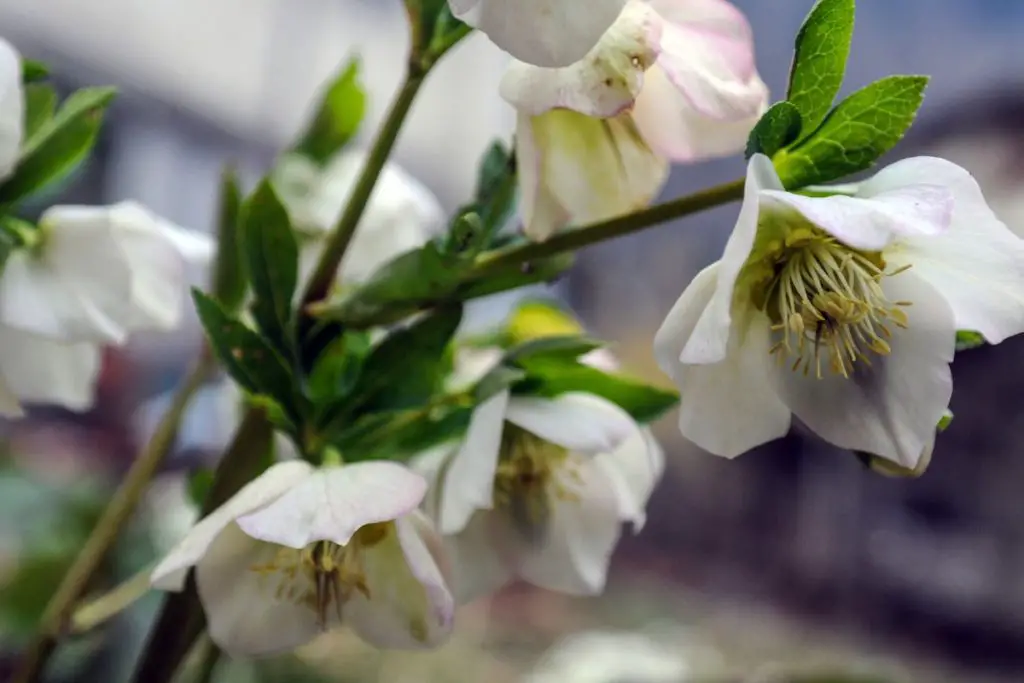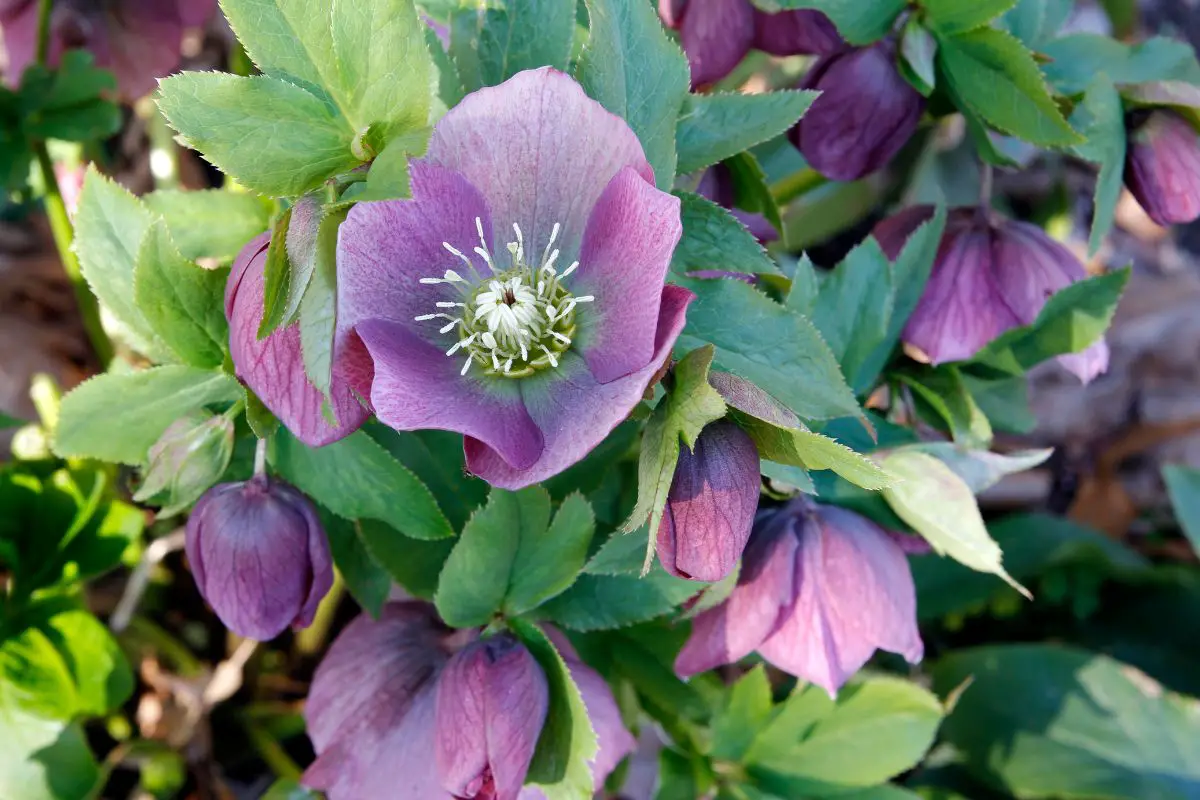Hellebores make a lovely addition to any garden. They are long-lived evergreen perennials, with blooms that last several months. These plants are low-maintenance, deer- and drought-resistant, and flower in a wide range of colors from winter to early spring.
Table of Contents
How to Care for Hellebore
Hellebores are tolerant of a wide range of growing conditions. They perform best in partial shade with soil that is rich, moist, and well-draining. Caring for your hellebores is simple when you make sure they have the proper light and soil conditions.
Hellebores are usually planted from potted containers received from growers. These plants are available in seed packets but, like natural seedlings that appear under the plant in your garden, they include a mix of colors. To grow a specific color it is necessary to purchase potted nursery starts.
Hellebores Growing Zone
Most commercially available hellebore plants are cold-hardy in Zones 4-9. There are about 20 species of this flower. A member of the buttercup family, most species are native, primarily, to Europe and western Asia. Various species have been cultivated in European gardens for centuries, but not until recently was there an interest in cultivating hellebores in North America.
Higher summer temperatures in places like the southern United States can limit plant growth and survival. It is reported that temperature ranges for optimum growth occur between 50-86 degrees. This can vary some between the different species within the Helleborus genus.
The commonly named plant, stinking hellebore, has good tolerance to high temperatures based on its native habitat. This variety of hellebore is widespread in western Europe, Portugal, Great Britain, and Germany. It grows from sea level, up to an elevation of approximately 7,000 ft.
A natural hybrid of the hellebore species, the Lenten rose, is thought to have the greatest tolerance to heat. It is native to southwestern and eastern Europe, and it grows naturally from sea level to an elevation of about 6,000 feet above sea level.
The variety with the common name Christmas rose has the least tolerance for heat but is valued in breeding programs for its large outward-facing flowers. There are a lot of different hellebore varieties so always be sure to check the tag before you put one in your garden. Source.
Shade or Sun?
Hellebores are wonderful for areas that are part to full shade, areas like a woodland garden, underneath a deciduous tree, or possibly an area next to the house that gets morning sun but afternoon shade. They will do well in these areas with the proper hellebore care. Just be sure to protect them from the hot, afternoon sun.
Watering Your Hellebores
Watering is another important factor in keeping your hellebores healthy and beautiful. You want to make sure that you keep your hellebores well-watered in the spring and fall months because that’s when they’re most actively growing. Keep the soil moist without allowing for standing water.
You don’t need to give them as much water in the summertime because this is their dormant period. Hellebores are somewhat drought tolerant but if you live in an area with long hot dry spells, or you have newly planted hellebore, you will want to keep them consistently well-watered.
Soil Requirements | Hellebore Care
Hellebores will thrive in soil that is rich, moist, and well-draining. You can add some compost to the soil when you plant them. You might also add some organic matter or compost annually, for consistently well-blooming Hellebores.
Also, they prefer a soil pH that is on the neutral to the slightly alkaline side, which is good if you live in an area with high alkaline soil. You can add garden lime if you have more acidic soil. This will bring up the pH of the soil and make your hellebores perform well.
Another note on soil, when you put your hellebores in pots you want to use a good potting mix and not garden soil. This is because garden soil will settle and not give enough room for the root system.
Fertilizing Your Hellebores
Is it necessary to fertilize hellebores? The simple answer is yes. While adding compost into the soil where you plant your hellebores is often sufficient, fertilizing ensures that your hellebores will produce all those gorgeous blooms repeatedly.
In the early spring, you can feed your hellebores with an organic fertilizer. Using a common 4-3-4, with nitrogen, phosphorus, and potassium, is quite sufficient. As with other perennials, sprinkling a fair amount around the drip line is the way to go. But, If you have a thick layer of mulch and/or landscape fabric, you’ll want to pull those away from underneath where you plan to apply the fertilizer.
You can use a liquid fertilizer for your containerized hellebores when they are blooming in the spring and a liquid grow in the fall months. As we mentioned earlier it is not necessary to use fertilizer in the summer because this is their dormant period.
Pruning Your Hellebores
One of the appealing things about hellebores is that they are very low-maintenance plants. Since their foliage is evergreen, they add value to your garden year-round.
They do require some maintenance, however. In the early spring, you will notice that some of the older leaves may look a little worn and tattered. It is best to take those leaves and prune them back to the stem.
The same can be said for the bloom stalks. When your hellebores have mostly all bloomed and they are no longer visually pleasing, you can take that bloom stalk and, once again, cut it all the way down to the base.
There is a variety of hellebores called the bear’s foot hellebore that carries its blooms from the next year on its current bloom stalk. So, make sure that you do not cut that bloom stalk off for that variety. You want to make sure to leave those bloom stalks if you want to have blooms next year.
Pests and Disease
Another wonderful aspect of these beautiful perennials is their tolerance for pests and diseases. One thing that you want to watch for is rot at the base of the plant. This is often caused by adding mulch, or compost above the crown of the plant.
There is a simple solution to this problem. Just make sure that the soil or mulch around your hellebores is away from where the stalks meet the roots of your plant. Usually, you do this when planting, but if you find you are having a problem, a quick check around the base of your hellebores should tell you if this is your issue. If your hellebore looks like it is drooping, don’t worry, the blooms naturally droop.
Also, you may notice slugs or snails on or near your hellebores. Once again, there is a simple solution to this problem. Adding diatomaceous earth is a great, organic means of pest management. It is effective for killing everything from fleas and roaches indoors, to aphids and slugs outdoors. Source.

Dividing and Transplanting
Hellebores rarely need to be divided but if you are going to do so the best time is in the fall. The same goes for transplanting. They can be a little fussy about being messed with though, so only do it if you feel it’s necessary.
See our article Dividing Hellebores
Toxicity
Our last point is toxicity. Hellebores are toxic to kids and pets. I have a lot of hellebores in my garden with a couple of dogs and cats, and they have never bothered them at all. Most animals probably avoid hellebores out of instinct, but just be aware that they are poisonous.
See our article Are Hellebores Poisonous?
Related Questions
Should you deadhead hellebores?
It is not necessary to deadhead hellebores and it is not going to encourage new blooms, so, if that’s what you’re looking for, then spending the time to deadhead them is not recommended. That being said, since hellebores bloom so early, some of the blooms can start to look old and tattered, especially with the arrival of some of the new blooms, therefore, removal of some of the old blooms is perfectly acceptable.
Should I cut old leaves off hellebores?
Absolutely, removing old growth not only tidies up the look of your garden but also helps new growth and flowers show. A good time to prune your hellebores is late winter or early fall depending on your climate area.

